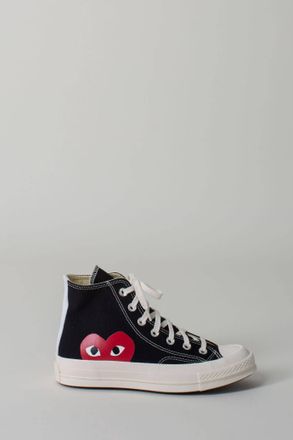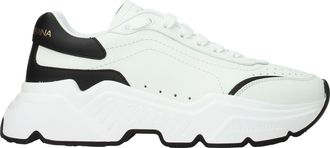Basic Trainers / Training Shoe
Basic Trainers / Training Shoe

-17%
Golden Goose
Super Star Sneaker In Blue Leather And Ice Suede
£175.00
£212.00
Balardi

Dolce & Gabbana
DG leather sneakers White
£575.00
Mytheresa

-15%
Hogan
Interactive ³ Black
£293.00
£343.00
Balardi

Russell & Bromley
REDBURN Mens Brown Classic Trainer
£225.00
Russell & Bromley

Off-white
Vulc Undercut Sneakers White
£256.00
Balardi

-30%
Chloé
Lauren leather sneakers Beige
£292.00
£418.00
Mytheresa

-36%
Alexander McQueen
Alexander Mc Queen Court Leather Sneakers Grey
£283.00
£440.00
Balardi

Moncler
New Monaco leather sneakers White
£360.00
Mytheresa

-12%
Crime London
Sk8 Deluxe White Military Sneaker
£169.00
£193.00
Balardi

Alexander McQueen
Oversized leather sneakers Black
£460.00
Mytheresa

-12%
Crime London
Distressed Platform Gold Sneaker
£169.00
£193.00
Balardi

-74%
Diesel
Vintage Effect S-LEROJI MID Sneakers size 40,5
£62.06
£242.44
GLAMOOD

-2%
Dolce & Gabbana
White Nappa Leather Portofino Sneakers
£398.00
£406.00
Balardi

-18%

-9%
Maison Margiela
Sneakers Black
£473.00
£518.00
Balardi

-40%
Versace
GRECA SOLE LEATHER SNEAKERS Size: 40, colour: BLACK
£252.00
£420.00
Circle Fashion

-33%
Alexander McQueen
Alexander Mcqueen Oversized Sneakers Black
£379.00
£563.00
Balardi

-50%
Off-white
Leather OUT OF OFFICE Mid-top Sneakers size 47
£188.22
£376.44
GLAMOOD

-15%
Emporio Armani
Leather Sneakers Black
£216.00
£254.00
Balardi

-17%
Veja
Campo Sneakers Veja White/Khaki Leather
£167.00
£201.00
Balardi

-30%
Tory Burch
Howel Court leather sneakers White
£150.00
£215.00
Mytheresa

-19%
Alexander McQueen
Alexander Mc Queen Oversized Leather Sneakers Black
£355.00
£440.00
Balardi

Alexander McQueen
Oversized leather sneakers White
£460.00
Mytheresa

-26%
Alexander McQueen
Alexander McQueen Idee regalo Sneakers kids Uomo Pelle Nero/Bianco
£207.00
£279.00
Balardi

Russell & Bromley
HARLEY Mens Navy Leather Unlined Trainer Blue
£250.00
Russell & Bromley

-46%
Jimmy Choo London
C Star Leather Sneakers White
£358.00
£664.00
Balardi

-20%
Lanvin
DBB1 suede and leather sneakers Black
£300.00
£375.00
Mytheresa

-15%
Maison Margiela
Grey And White Replica Sneakers
£486.00
£572.00
Balardi

-75%
Marcelo Burlon
Suede and Leather TICINELLA Low-Top Sneakers with Contrast S size 40
£78.24
£312.96
GLAMOOD

Veja
Sneakers White
£156.00
Balardi

-16%
Oliver Sweeney
Mens Oliver Sweeney Hayle Antiqued Calf Leather Mens Trainers - Navy - Size: 11 Blue
£133.56
£159.00
lovethesales

-64%
Jimmy Choo London
Diamond Jc Monogram Glitter Leather Sneakers Black
£313.00
£872.00
Balardi


-23%
adidas Originals
Adidas Originals Sneaker Samba Lt Core Black/Cloud White/Gold Metallic
£93.00
£121.00
Balardi

-40%
CONVERSE X COMME DES GARCONS
Converse CDG Play High Blue
£90.00
£150.00
Labels

-27%
adidas Originals
Adidas Originals Samba Decon
£118.00
£161.00
Balardi

Valentino Garavani
Rockstud Untitled leather sneakers White
£680.00
Mytheresa

-25%
Cesare Paciotti
Sneakers 4us Uomo Pelle Nero/Rosso
£156.00
£209.00
Balardi

CONVERSE X COMME DES GARCONS
Converse CDG Play High Black
£150.00
Labels

-12%
Premiata
Moerund 7799 Sneaker Black
£245.00
£279.00
Balardi

INUIKII
Shearling-trimmed suede sneakers Grey
£220.00
Mytheresa

-24%
Golden Goose
Ball Star Leather Sneakers Silver
£360.00
£475.00
Balardi

-25%
Versace
JEANS COUTURE Leather STARGAZE Sneakers with Contrasting Det size 36
£156.70
£208.94
GLAMOOD

-26%
Alexander McQueen
Alexander McQueen Idee regalo Sneakers kids Uomo Pelle Bianco/Rosso
£207.00
£279.00
Balardi

Autry
REELWIND LOW SNEAKERS IN BLACK NYLON AND SUEDE
£175.00
Autry

-17%
Veja
Campo Sneakers In Black And White Chromefree Leather
£167.00
£201.00
Balardi

Dolce & Gabbana
Logo leather sneakers Black
£525.00
Mytheresa

-26%
Dolce & Gabbana
Dolce&Gabbana Sneakers Uomo Pelle Nero
£438.00
£590.00
Balardi

-30%
See By Chloé
Essie leather sneakers Black
£294.00
£420.00
Mytheresa

-42%
adidas
Sneakers Superstar Donna Pelle Nero/Bianco
£69.00
£118.00
Balardi


-27%
adidas Originals
Adidas Originals Country Japan
£110.00
£150.00
Balardi

Christian Louboutin
Louis Spikes sneakers Black
£1,095.00
Mytheresa

-42%
Common Projects
Sneakers Donna Pelle Nero
£251.00
£434.00
Balardi

Russell & Bromley
ROLLER Womens Dark Green Suede Scalloped Lace Up Trainer
£195.00
Russell & Bromley

-3%
Autry
Medalist Low Leather Sneakers Silver
£167.00
£172.00
Balardi


-22%
Dolce & Gabbana
Portofino Leather Sneakers Black
£379.00
£483.00
Balardi

Veja
CAMPO LEATHER Size: 39, colour: BLACK
£125.00
Circle Fashion

-23%
Givenchy
Urban Street Sneakers Black
£373.00
£483.00
Balardi

Rick Owens
Jumbolace leather sneakers Black
£725.00
Mytheresa

-26%
Givenchy
Sneakers Spectre Uomo Pelle Nero
£554.00
£745.00
Balardi

Alexander McQueen
Oversized leather sneakers Black
£460.00
Mytheresa

-16%
Alexander McQueen
Alexander McQueen Sneakers Oversize Uomo Pelle Nero/Nero
£528.00
£632.00
Balardi


-9%
Golden Goose
Ball Star Leather Sneakers White
£389.00
£427.00
Balardi

-25%
Love Moschino
Sneakers Donna Pelle Bianco
£132.00
£177.00
Balardi

-26%
Dolce & Gabbana
Dolce&Gabbana Sneakers Daymaster Donna Pelle Bianco/Nero
£474.00
£638.00
Balardi

-37%
Off-white
Off White Out Of Office Mid Top Sneakers Blue
£407.00
£647.00
Balardi

-53%
Doucal's
Smooth Leather Trainers Blue
£181.00
£386.00
Balardi

Premiata
Sneakers Pink
£250.00
Balardi

-5%
Puma
Speedcat Mid
£123.00
£129.00
Balardi

-32%
Golden Goose
Sneaker Hi Star White/Pink/Dark Green
£318.00
£471.00
Balardi

-32%
Tod's
Tods Tabs Suede Leather Sneakers Blue
£353.00
£518.00
Balardi

-5%
Off-white
Low Vulcanized Canvas Sneakers White
£248.00
£260.00
Balardi

-23%
Alexander McQueen
Alexander Mc Queen Sneakers White
£373.00
£483.00
Balardi

-8%
Golden Goose
Sneaker Ball Star White Latte/Gold
£410.00
£447.00
Balardi

-4%
Golden Goose
Sneakers White
£453.00
£470.00
Balardi

-28%
Dolce & Gabbana
Portofino Leather Sneakers White
£348.00
£483.00
Balardi

-7%
Lauren Ralph Lauren
Franky
£138.00
£149.00
Balardi

-32%
Tod's
Tods Tabs Suede Leather Sneakers Brown
£353.00
£518.00
Balardi

-8%
Golden Goose
White/Metallic Blue Ballstar Sneakers
£410.00
£447.00
Balardi

-12%
Crime London
Sk8 Deluxe Gunmetal Sneaker Grey
£169.00
£193.00
Balardi

-27%
adidas Originals
Adidas Originals Gazelle Indoor Pro
£118.00
£161.00
Balardi

-26%
Christian Louboutin
Seavaste Leather Sneakers Blue
£645.00
£874.00
Balardi

-42%
Versace
Sneakers Greca Uomo Pelle Bianco/Dark Teal
£342.00
£590.00
Balardi

Autry
White/Green Medalist Sneakers
£170.00
Balardi

-27%
Puma
Speedcat Leather
£110.00
£150.00
Balardi
This season’s trends
- Towelling dressing gowns
- Timberland winter shoes
- Dressing gowns for women
- Paul Smith scarves
- Wool pea coats for women
- Alexander McQueen scarves
- Amazon dressing gowns
- Woolrich parkas
- Canada Goose winter jackets for men
- Fur fur jackets
- Winter shoes for women
- Winter coats for women
- Duffle coats for men
- Winter coats for men
- Winter jackets for men
- Winter shoes for men
- Gucci scarves
- Cashmere jumpers for men
- Snoods for women
- Half zip jumpers for women
- Duffle coats for women
- Bobble hats for women
- Gucci scarves for women
- Acne Studios scarves
- Half zip jumpers for men
- Pea coats for women
- Pea coats for men
- Ralph Lauren winter jackets
- Burberry scarves
- Dressing gowns for men
about products and deals

